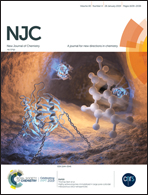Investigation of cation binding and sensing by new crown ether core substituted naphthalene diimide systems†
Abstract
Crown ethers are effective at binding cations and through substitution onto the core of photoactive naphthalene diimide molecules (NDIs), cation binding can be detected via changes in UV-visible absorption and/or fluorescence emission. In this work, two new NDI-crown ether cation sensors (aza-15-crown-5 ether NDI, 5, and aza-18-crown-6 ether NDI, 6) have been synthesised and changes in UV-visible and fluorescence spectra upon addition of various cations investigated. A substantial blue shift in the UV-visible absorption of 75 nm was observed for 6 with a 1 : 1 addition of Na+ or K+, providing a clear colourimetric readout, however, no significant spectral changes were observed for 5 with the cations trialled at this level of analyte. Calcium cations do, however, elicit a response from 5 at substantially higher molar ratios, with some perturbation of the absorption spectrum observable, and an approximately six-fold increase in fluorescence emission. Theoretical calculations indicate that for 6, K+ and Na+ bind to the ether oxygens resulting in a blue shift similar to that observed experimentally. Ca2+ however, was found to bind quite differently with 5via both the ether oxygens and the carbonyl group on the NDI. This observation highlights how small structural changes can lead to different and unexpected behaviour and that investigation of underlying binding mechanisms is important to inform the rational design of future systems.



 Please wait while we load your content...
Please wait while we load your content...